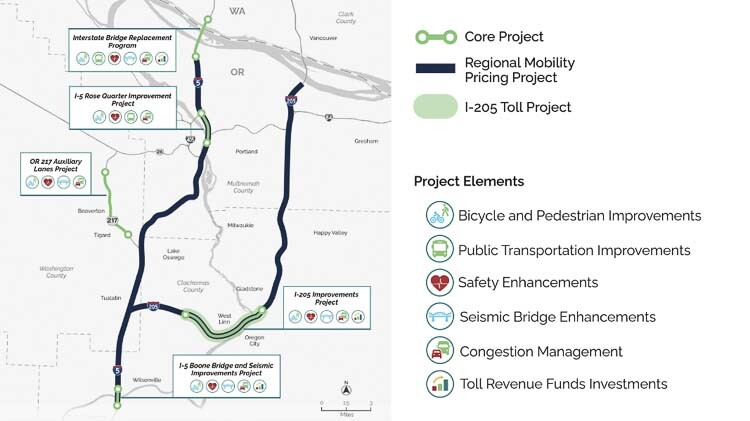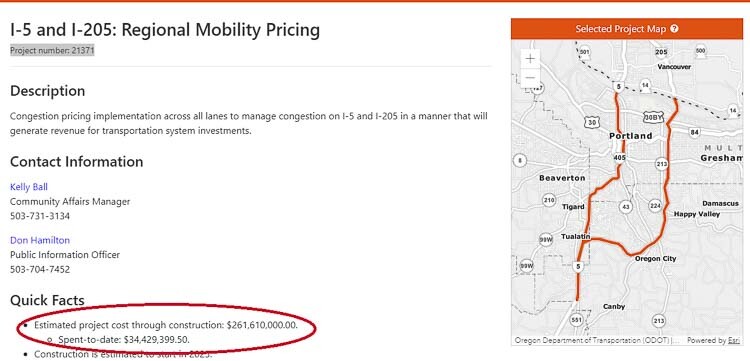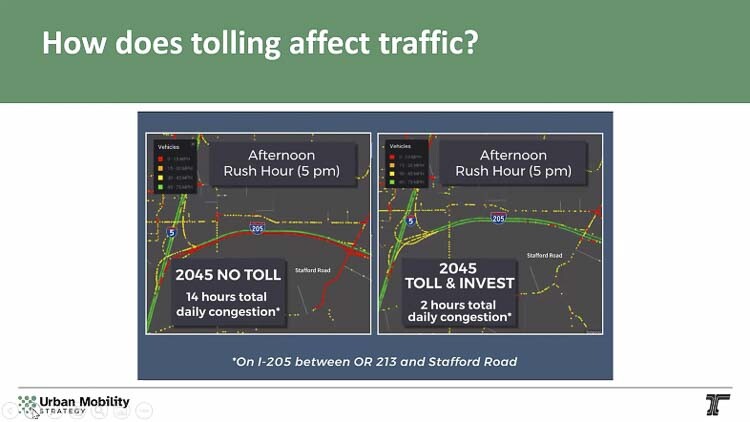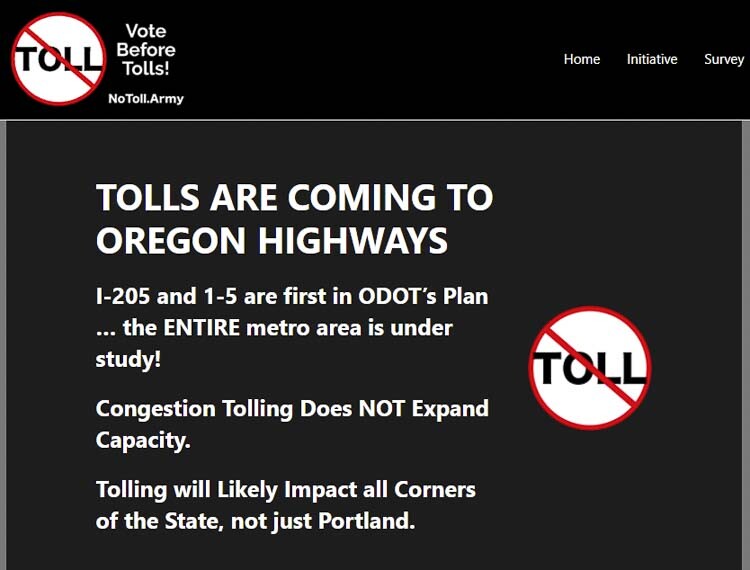RTAC is ‘tone-deaf’ to the concerns of people
John Ley
for Clark County Today
An Oregon Department of Transportation (ODOT) committee discussing the implementation of tolling on freeways and highways has been bogged down on defining traffic diversion, revenue sharing and transit issues. The Regional Tolling Advisory Council (RTAC) met Mon., Jan. 22 with the intention to discuss ways to implement their Regional Mobility Pricing Program (RMPP) “sooner.” The RMPP will charge a “per mile” tax for driving on roads that have been previously free.
“How are we convincing the public this is a good idea,” asked RTAC committee member Kasi Woidyla, who later noted “we feel very tone-deaf” to the concerns of people. The committee has met a dozen times over the past 18 months and still can’t agree on traffic diversion and doesn’t know if paying tolls will provide any value to drivers.
During the Jan. 22 meeting, traffic diversion was a major sticking point. Local entities have been promised funds for mitigating traffic diversion, but ODOT staff appeared to be unable to define what diversion was, and what qualifies for diversion money. “How we define diversion is key,” said Jon Isaacs of the Portland Metro Chamber.
Vancouver Mayor Anne McEnerny-Ogle is one of 25 members of the RTAC committee. She told them “C-TRAN loves TriMet!” in an enthusiastic statement supporting additional transit. McEnerny-Ogle described the “lovely partnership we have with TriMet,” but noted only C-TRAN offers transit on the interstate freeways as an alternative to driving.
She is generally supportive of the effort to raise money via tolling. The ODOT plan will toll all vehicles “from the border with Washington” driving both I-5 and I-205. It is estimated roughly 75,000 Clark County residents work in Oregon and would be paying the tolls.

The RMPP is a second toll ODOT plans to charge. There are also plans to charge for driving on the Interstate Bridge, the Abernethy Bridge, the Tualatin River Bridge, and potentially the Wilsonville Boone Bridge. Portland economist Joe Cortright has estimated the double tolls could cost between $28 and $31 dollars a day for a round trip between Salmon Creek in Vancouver and Wilsonville.
The Oregon Transportation Commission (OTC) will make the ultimate decision on how much toll rates will be. Oregon Gov. Tina Kotek issued an executive order pausing the collection of tolls until January 2026. ODOT officials are recommending lower rates and eliminating overnight tolls, among the various scenarios being presented.
Jana Jarvis of the Oregon Trucking Association (OTA) called out ODOT Director Kris Strickler for a “very confusing” letter on diversion. She noted it contained very conflicting statements. “ODOT plans to mitigate tolling impacts by avoiding or minimizing vehicle diversion,” reads the letter. Jarvis noted it is counter intuitive to the congestion pricing discussions the committee has had regarding managing congestion. “If you price it, people will use other roadways or modes, to get where they’re going,” she said.
She believes those on RTAC have a variety of different understandings of what diversion is. “In order to have clarity about this discussion, we need to know how we’re defining diversion,” she said. Jarvis is getting increasingly confused about what the objectives are in the discussion. Strickler said his agency includes “the trip not made” in their definition of diversion.
Sarah Iannarone spoke about “good diversion,’’ where people switch to using transit. She’s director of the Street Trust, which supports getting people out of their cars. “Excess toll revenues and ODOT are not something I usually use in the same sentence,” she said, pushing for more investments in multimodal and active transportation. Iannarone mentioned the Interstate Bridge Replacement program (IBR) of getting more money included for the type of transportation she favors.
ODOT had previously indicated there would be some form of revenue sharing with local communities to offset the impacts of traffic diversion. That was called “woefully inadequate” by Clackamas County Commissioner Paul Savas and others. West Linn Mayor Rory Bialostosky wanted to know “what revenues are available to share?” He highlighted ODOT’s current funding shortage of $2.6 billion to $3.3 billion.
Stricker told the group he didn’t expect 100 percent agreement, but “something we can live with” regarding net toll revenue allocation. Brandon Finn, director of ODOTs Urban Mobility Office, spoke to the committee about compromise. “We know that not everyone is going to get what everyone wants,” he said.
Many on the committee have questioned if there will be any “excess revenue” to share. Recently, Bialostosky revealed ODOT expects an 83 to 86 percent cost of collection on their tolling system.

Strickler agrees there needs to be further specificity on revenues and when they might be allocated. He wondered if some people were talking about 30 years in the future, once the tolling bonds were paid off, or more immediately.
C-TRAN CEO Shawn Donaghy highlighted the fact that if ODOT didn’t properly designate HOV lanes, Clark County’s transit agency could lose millions in federal funding. Right now, C-TRAN offers the only bus service over the Columbia River into Portland. The lanes need to be designated as full toll lanes or HOT (high occupancy toll) lanes, according to Donaghy. He noted C-TRAN is the 4th largest transit agency in Oregon.
To date, ODOT has spent $34.4 million on tolling planning and community outreach according to one report. They expect to spend $261 million on “congestion pricing implementation across all lanes to manage congestion on I-5 and I-205 in a manner that will generate revenue for transportation system investments.” Those numbers don’t seem to add up in a manner that will generate reasonable net revenues.
Clackamas County is ground zero for the impacts of the tolling. There are no transit options for almost all county residents to consider as an alternative. “We are a transit desert,” said Savas. He showed a map highlighting the lack of alternatives for his constituents to avoid paying the tolls, including transit. “Over 70 percent of Clackamas County residents leave the county for work,” Savas said.
Traffic diversion is a huge concern for communities along I-205. In many cases ODOT has estimated the number of vehicles on side roads in Oregon City, West Linn, Gladstone, Canby, and Lake Oswego, will potentially double. That will be devastating for drivers, schools, businesses, and families who live in these communities. This has been highlighted multiple times, at a September Tualatin Chamber of Commerce event, and legislature transportation listening sessions in December and January.
Metro Councilor Christine Lewis had multiple conversations in the week prior with many of the RTAC members in preparation for briefing the OTC. “The tolling will increase diversion onto local streets, increasing local congestion, and decrease safety on local streets,” she said. She shared they must come up with a comprehensive and equitable revenue sharing program that addressed everyone’s needs.
“We need alternatives to some of these highway trips,” Lewis said. She also said it would be unacceptable to raise toll rates just to generate more revenue. “Our constituents are not looking to pay more, just so local governments can have revenue share.”
Issacs also interviewed many RTAC members, but started his presentation by saying “if there is any net tolling revenues.” Why would we have net revenue, several members told him. “We shouldn’t be tolling just to produce revenue,” he said. “One of our goals is reduced use of freeways,” Isaccs commented, noting the entire system is gridlocked.
“Those paying the tolls should get some value for their money,” Issacs emphasized. Savas reminded them that ODOT promised the two phases of the I-205 project would eliminate 12 hours of traffic congestion. Now that the second phase (7 miles of new lanes) has been canceled, there has been no update on how many hours of traffic congestion will be eliminated just by tolling.

“Oregon has under invested in transportation historically,” said Jarvis. “I-205 was the last major project we have done,” she emphasized. Her remarks were echoed by a representative of the Port of Portland.
“Trucking has paid the most in taxes and fees for transportation in Oregon,” Jarvis said. A week later, the OTA filed a lawsuit against Oregon, ODOT and the Governor alleging truckers have been disproportionately and grossly overcharged for road use under the state’s weight-mile tax.
TriMet’s JC Vannatta said funding transit would be very difficult. “I’m not sure how much money would be left to share,” he said. Vanetta told Mayor Ogle “there’s a lot of love for you as well,” perhaps in reference to Vancouver’s support for light rail on the IBR.
Matt Ransom, director of the Regional Transportation Council (RTC) asked that they remember “the other state” in reference to the tens of thousands of SW Washington residents who work in Oregon. He emphasized that if the OTC were to view this as a partnership, many problems could be reduced.
But the diversion problem in Washington is different, Ransom noted. “You either cross the river or you don’t,” he said. Ransom believes we will need an aggressive demand management program. WSDOT’s Carley Francis said “there’s no resource that will fix all the problems.”
Iannarone wants to fund alternatives to driving. She noted Governor Kotek has one priority for the current Oregon legislative session – housing. That is a common sentiment among many on the Oregon side of the river. But taxing drivers to fund those alternatives raises the ire of many.
A week later, the Washington State Transportation Commission raised maximum toll rates 50 percent on I-405 and SR-167 in the Puget Sound. They also created three tolling zones, so a one way trip on the entire corridor could cost drivers $45. This should serve as a significant warning to Oregon drivers.
During public comment, Dean Suhr reminded the committee citizens are collecting signatures for IP-4, to guarantee a vote before tolls can be put on any Oregon highway.

Also read:
- Plan ahead for ramp closures on I-5 near Ridgefield, July 9-10WSDOT will close three I-5 off-ramps near Ridgefield July 9–10 to test wrong-way detection systems and improve safety.
- Delays expected on Northwest 99th Street during water quality project constructionClark County will begin construction in July to install a stormwater filter vault on NW 99th Street. Drivers can expect delays, but lanes will remain open during the work.
- POLL: What’s the biggest concern you have with the current I-5 Bridge replacement plan?As costs rise and Oregon’s funding fails, concerns mount over the current I-5 Bridge replacement plan. Clark County Today asks readers: what’s your biggest concern?
- Plan ahead for ramp closures on I-5 near Ridgefield, July 8-9Travelers on northbound I-5 near Ridgefield should prepare for ramp closures July 8–9 as WSDOT crews conduct final testing of new wrong-way driving detection systems. The closures affect exits 9 and 11, including the Gee Creek Rest Area.
- Oregon DOT director calls transportation funding bill failure ‘shocking,’ warns of layoffsODOT Director Kris Strickler warned staff that up to 700 layoffs are imminent after lawmakers failed to pass a transportation funding bill, deepening the agency’s $300 million shortfall.









